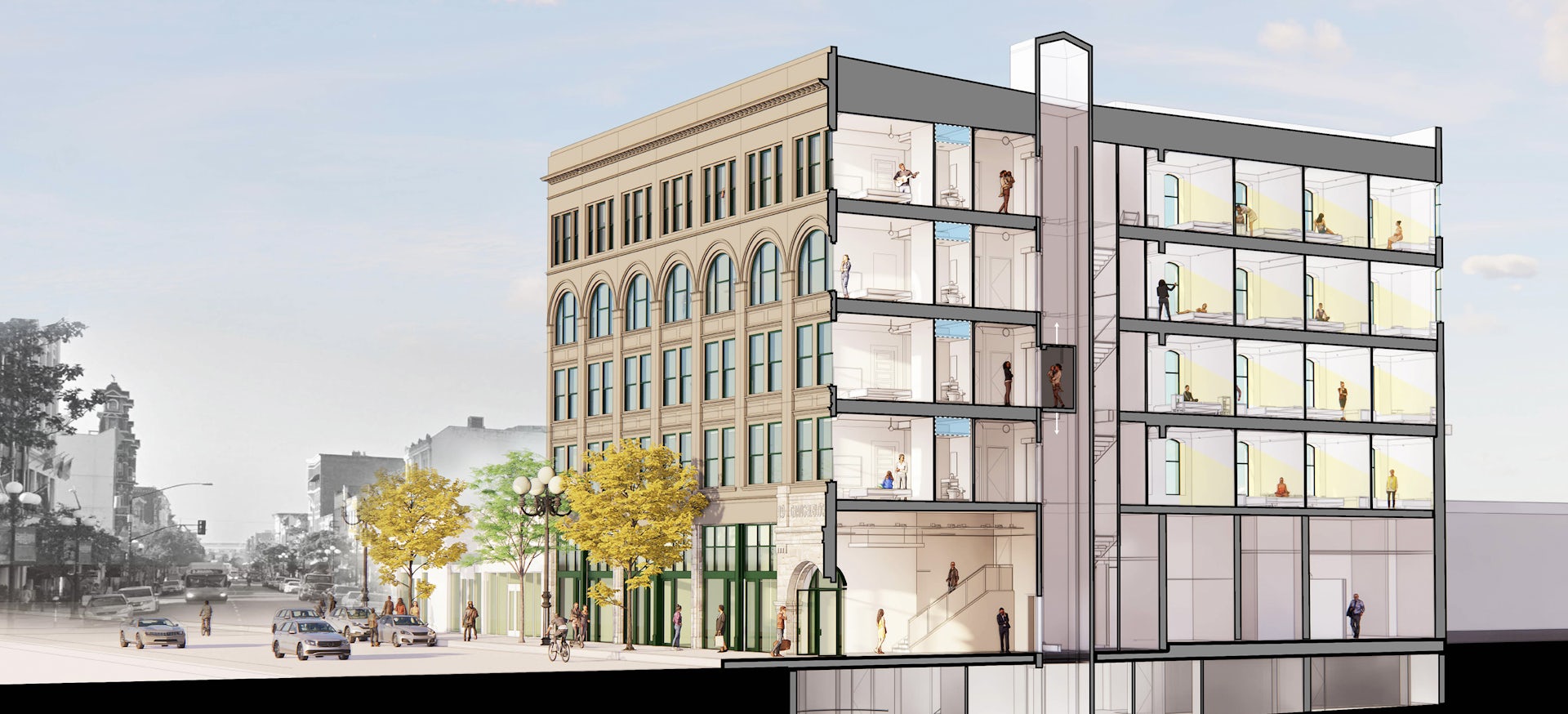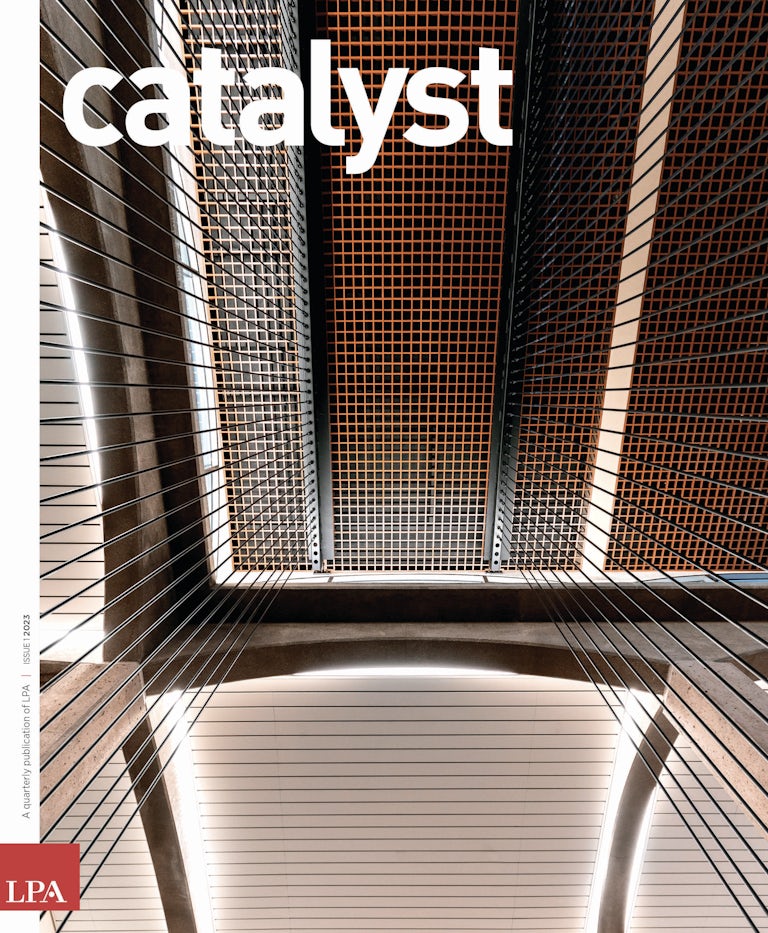Office-to-residential conversions sound good, but they often don’t make economic sense. The adaptive reuse of a historic San Diego building illustrates how creative design can create value and make the numbers add up.
A wave of office-to-residential conversions is expected in the years ahead, judging by industry reports and conference panel discussions. Around the country, cities are offering financial incentives for residential adaptive reuse projects, and building owners are exploring their options, as office vacancy rates rise and demand for housing skyrockets.
But there are a few problems in the office-to-residential scenario. For many office building owners, a residential conversion simply doesn’t make economic sense. The cost of the structural and mechanical upgrades, as well as the labyrinth of the permitting process, make residential too expensive, especially for owners carrying debt on a property.
“There are many factors that must line up correctly for a potential conversion project to work, including financing, construction costs, local zoning and the building’s structure and floorplate,” Mike Watts, CBRE Americas, president of investor leasing, said in a recent report. “Conversions can be the solution in some cases, but not for all outdated or obsolete office buildings.”
Yet, looking ahead, there is still an opportunity for many owners to repurpose aging office buildings to address the demand for badly needed homes. But the challenges are real. Making office-to-residential conversions practical requires design strategies that go beyond the traditional approaches to cut costs and create financially viable projects.
“A clean, simple tenant improvement with the minimum amount of intrusion is how we mitigate cost and risk for our owners,” LPA Director of Mixed-Use, Matt Winter says.
A clean, simple tenant improvement with the minimum amount of intrusion is how we mitigate cost and risk for our owners.
Efficient Adaptive Reuse
The adaptive reuse of a 118-year-old office building in downtown San Diego provides an illustrative example of how a creative design approach can overcome the obstacles to an economically successful residential conversion. The reuse plan developed by the client and LPA designers calls for 104 hotel-style units in a building that had primarily been used for executive suites and retail in recent years. (A portion of the units will have kitchenettes in them to give the owner additional rental options.)
In many ways, the Romanesque-style building was an ideal candidate for adaptive reuse. The office vacancy rate for San Diego County was 13.4% in the third quarter of 2022, according to real estate firm Cushman & Wakefield, with some areas of downtown over 20%. Older buildings tend to be the best candidates for conversion. More than 80% of the buildings converted in the U.S. in the last decade were more than 50 years old, and most, like this one, were eligible for historic preservation tax credits, according to a study commissioned by the NAIOP Research Foundation, the research arm of the Commercial Real Estate Development Association.
For an owner, there are myriad potential benefits of an adaptive reuse project. Reusing the existing structure is more environmentally friendly than new construction, the permitting process can be easier, and the construction timeline is shorter, the NAIOP study found. Per-unit costs are typically 30% lower for an adaptive reuse compared to new construction, with faster completion times and lower material and labor costs, the NAIOP report notes.
Approaching older buildings with an open mind and exploring the potential of the existing materials in the context of the financial realities can lead to creative answers. “Every project is unique, and looking at each one with fresh eyes and not being driven by any kind of formulaic approach is really important,” LPA Design Director, Matthew Porreca says. “It’s about doing the due diligence and understanding the constraints and then being creative and thoughtful about those design opportunities that exist.”
For this project, an earlier design effort from a previous development team had called for gutting the building, tearing out the walls and rebuilding the interior structural system, which would have cost millions more than the owner’s budget. LPA’s design process started with a focus on what could be used in the existing structure, and within the parameters of the building code.
“We did a very specific analysis of the building to find things we didn’t have to do,” Winter says. “By digging deeper, we were able to take significant cost out of the project.”
LPA’s design process started with a focus on what could be used in the existing structure, and within the parameters of the building code.
Searching for Alternatives
LPA designers focused on three key areas where the design could impact the viability of the project — the structure; floor and walls systems; and the doors and windows.
The previous development effort included an entirely new secondary structural system. After selective demolition and exploration, the structural engineering team was able to demonstrate that the building met the requirements for the new use type and did not require extensive upgrades.
The earlier design efforts also called for removing the existing wall system and using current prescriptive fire-rated walls and fire-rated ceilings. The cost of creating a new wall and floor system would have essentially scuttled the project, and those plans would have destroyed all the historic interiors. Working closely with the authority with jurisdiction, the LPA team focused on documenting the viability of existing wall and floor systems. Using the archaic materials, fire-protection engineers were able to build out a prescriptive wall type that meets existing building code standards for the required ratings. They even used data from a test done on a similar floor system conducted by MIT engineers in 1918.
Ultimately, floor and wall systems met state and local building codes, as well as codes for historic buildings. “We were able to describe the existing system and then build a prescriptive wall type that the building department could sign off on,” Winter says.
The historic glass doors, an important element in the building’s style and ambience, did not meet current code for hallway ratings, either for fire or sound. They also included transom windows. Residential code typically requires more-robust doors and no glass. But replacing the doors and windows would also escalate costs and remove one of the building’s most charming features, as well as jeopardize the historic tax credit status.
The solution was a system of smoke seals and retrofits that saved the doors. The key was a portion of California Historic Building Code that allowed the use of archaic materials, as long as specific requirements were met.
Similar efficiencies and design alternatives were found throughout the project. Despite the complexities and historic designation, the design created an economically feasible project that allowed the owner to move forward with a project that transformed the building’s role and created new value.
“I think it’s a perfect example of great revitalization and adaptive reuse for an existing structure, which is always the most sustainable approach,” Porreca says. “And it’s giving the building a whole new life for the next generation, an approach that keeps the building active and occupied to ensure its preservation.
Finding an Office-to-Residential Solution
At first, repositioning an 118-year-old office building for residential was labeled as too expensive and impractical. But LPA designers worked with the client to develop a reuse plan that used the existing structure, wall and door systems to meet building and historic codes. The final design illustrates how a creative approach can overcome obstacles to develop an economically feasible residential conversion.







